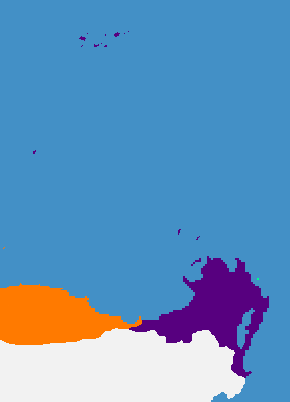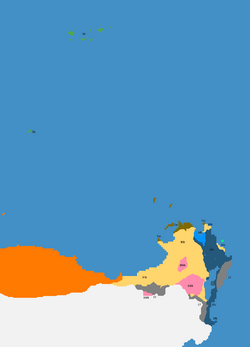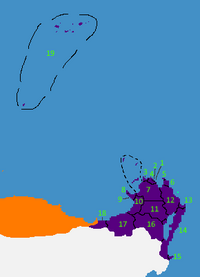Mathral: Difference between revisions
Posadastan (talk | contribs) |
Posadastan (talk | contribs) |
||
| Line 80: | Line 80: | ||
===Pre-colonization=== | ===Pre-colonization=== | ||
Around 500BCE was when contact with other groups in modern day AusValia and Bathelonat began to resume, as domesticated wildlife and some smaller shipbuilding allowed for more contact and intermingling along the northern coast of Kaniq. | |||
It was not until around 650CE however, that those not from Kaniq began to visit, opening up some very early trade and "discovery," including the early forms of the modern Mathrali script (which itself emerged around 1050CE). This period began to be known as the "5 Ports Period," where the various tribes fought and aligned with one another for control of one of the 5 strategic ports necessary for early trade. This period saw the establishment of many of the country's modern cities like Bochō, though some others weren't truly developed until later on. | |||
It was during the 5 Ports Period that many foreign tradesman, especially those from [[Buyo]] would begin to travel through and occasionally settle in these port areas, as well as establishing a tributary state to the Buyonese crown in the yet-uninhabited Bohwa Islands in ~1360CE. Around 1600CE, many of the tribes had established themselves as sovereign entities, most of whom traded primarily with one another or the Buyonese traders and settlers, who existed mostly in a peaceful way. | |||
This would lead to a 200-year long period known as the "Pax Buyonica" where all tribal kingdoms coexisted peaceful, with very little conflict. | |||
===Colonial Era=== | ===Colonial Era=== | ||
Revision as of 22:32, 19 July 2024
This article is incomplete because it is pending further input from participants, or it is a work-in-progress by one author. Please comment on this article's talk page to share your input, comments and questions. Note: To contribute to this article, you may need to seek help from the author(s) of this page. |
Federal Republic of Mathral Rhebaboliki ya Feterale ya Mathral | |
|---|---|
|
Flag | |
| Motto: In Unity and Liberty! | |
 Map of Mathral | |
| Capital and largest city | Hochōborha |
| Official languages | Mathrali |
| Religion | 48% Christian 26% Atheist 21% Folk 5% Other |
| Demonym(s) | Mathrali, Momathral |
| Government | Federal multiparty parliamentary republic with an executive presidency |
• President | Bomo Nchatinya |
• Vice-President | Tsisi Kokonhwa |
• Parliament Speaker | Vantu Tsokwane |
| Legislature | Parliament |
| Establishment | |
| Area | |
• Total | 791,607.3 km2 (305,641.3 sq mi) |
| Population | |
• 2025 census | 9,107,400 |
• Density | 11.5/km2 (29.8/sq mi) |
| GDP (PPP) | estimate |
• Total | $177.29B |
• Per capita | $19,467 |
| GDP (nominal) | estimate |
• Total | $81.08B |
• Per capita | $8,903 |
| HDI (2025) | 0.764 high |
| Time zone | UTC+03:00 (PST) |
| Date format | dd/mm/yyyy |
| Driving side | right |
| Calling code | +212 |
| Internet TLD | .ml |
Mathral, or the Federal Republic of Mathral, is a small, isolated republic on the southern continent of Kaniq in Telrova. With its cold climate, rolling steppes and snowcapped mountains, the sparse population, centered primarily around a few coastal cities and islands, is made up primarily of indigenous Mathrali citizens, along with a mixture of neighboring and colonizing ethnic groups. It is notable for being one of a few countries in Telrova to have a tricameral system of governance as well.
The nation is bordered to the west by the Kingdom of Bathelonat and is bordered at sea by an island belonging to Socialist Platypus. The country is well-renowned for its landscapes and multicultural society. It is also one of the most sparsely populated countries on all of Telrova, with only 11.5 people per square kilometer (29.8 per sqmi).
The nation also enjoys relative stability, having an unbroken chain of democracy since it was freed from colonial rule in 19XX, and having few regional rivalries, with the exception of a dispute of the Tachinya Island with neighboring Bathelonat. It is defended by the Mathrali Defense Forces and has neutrality enshrined into its constitution.
Etymology
History
Pre-History
The early history of Mathral saw the continent of Kaniq split from nearby Ost-Gershaft nearly 80 million years ago, where it drifted south towards its current location.
In the several million years since, with the southward drift, the continent got continually colder, and much of the southern and eastern ends pushed up and slid against neighboring tectonic plates, creating vast mountain ranges and glacial coverage. Much of the nation today exists in the steppes, or rather flat environments brought about by vast glacial erosion, with much of the south and east being mountainous, and the Ngakwan river valley was also formed by glaciers and glacial melt/runoff, allowing for tons of grazing for the endemic wildlife.
The region was also first home to human settlement around 6,000 years ago, as nomads and seafarers from Narushia and Pukam settled the western end of Kaniq. The nomadic peoples of this era slowly settled towards the east, inhabiting modern-day Mathral around 4,500-4,000BCE. During this time, many of the 8 modern tribes began to form, some taking to the mountains, some to the river valleys, and some to the steppes and deserts.
Most settlements remained fairly nomadic during this time, but some limited sedentarization began around 1,200-1,000BCE, with large mound-like structures and stone structures being constructed, as well as more complex communities and tools.
Pre-colonization
Around 500BCE was when contact with other groups in modern day AusValia and Bathelonat began to resume, as domesticated wildlife and some smaller shipbuilding allowed for more contact and intermingling along the northern coast of Kaniq.
It was not until around 650CE however, that those not from Kaniq began to visit, opening up some very early trade and "discovery," including the early forms of the modern Mathrali script (which itself emerged around 1050CE). This period began to be known as the "5 Ports Period," where the various tribes fought and aligned with one another for control of one of the 5 strategic ports necessary for early trade. This period saw the establishment of many of the country's modern cities like Bochō, though some others weren't truly developed until later on.
It was during the 5 Ports Period that many foreign tradesman, especially those from Buyo would begin to travel through and occasionally settle in these port areas, as well as establishing a tributary state to the Buyonese crown in the yet-uninhabited Bohwa Islands in ~1360CE. Around 1600CE, many of the tribes had established themselves as sovereign entities, most of whom traded primarily with one another or the Buyonese traders and settlers, who existed mostly in a peaceful way.
This would lead to a 200-year long period known as the "Pax Buyonica" where all tribal kingdoms coexisted peaceful, with very little conflict.
Colonial Era
Modern Era
Geography & Climate
Climate
Most of Mathral is home to a rather cold climate, with some coastal areas and the Bohwa Islands being slightly more temperate, often being of Cfc and Csc classifications. Meanwhile much of the non-coastal mainland is home to a vast semi-arid to arid steppe environments (BSk & BWk), home to a great many historically nomadic groups. Then through the heartlands and much of the East, there is a Dfb to Dfc climate, where it is rather humid and coniferous, but also quite cold.
Many large mountain ranges also line the eastern coast and areas surrounding the Lake Mvānye, as well as the southern reaches of the border, much of it being classified as sparsely inhabited tundra (ET). Because of this, much of the population is centered around coastal regions, or the Csc areas, where summers tend to be dry and cold, with summertime temperatures rarely exceeding 15 Celsius and winter temperatures rarely dipping below 0 Celsius, giving a good stability to the weather of those regions.
Nature
Government & Politics
Government Structure
The structure of the Mathrali government is a unique one, with it being described as unicameral, bicameral, and unicameral by various scholars, though it consists of the following:
- House of Chiefs: This is an advisory body to the People's Chamber, aka Parliament, wherein 8 members are hereditary chiefs (who may not belong to any political party), 20 members are elected by various tribal councils, 2 members represent the mainland and island-swelling Ziromnian settlers, and the remaining 5 members are appointed by the president. This totals to 35 members, who's powers are almost purely advisory. All bills affecting tribal organization, property, customary law, and the administration of customary courts go through the house before being discussed by the Parliament. The body must also be consulted when changes to the constitution or declarations of war are made. Lastly, the body has the power to summon members of the government to appear before it. There exists no term limits in the House of Chiefs.
- People's Chamber (Parliament): The Mathrali People's Chamber, aka the Mathrali Parliament, is composed of 85 members, 5 from each of the 19 regions split proportionately amongst the most voted for parties in said regions (typically requiring a party to get at least 20% of the vote). It has the traditional Speaker, Deputy Speaker, and a Leader of the Opposition. If desired, two-thirds of the members can vote to recall a Speaker. In general, the main purpose of the parliament is to debate and pass bills. Typically, the president introduces a bill to the parliament before they examine it, renegotiate, debate, then send it to the House of Chiefs for approval before they can finally vote on it and send it back to the president (with a simple majority) who can veto or pass it into law. The parliament can also check the president's emergency powers (as they must approve of the emergency regulations) and elect the president to act as the head of state and the nominal head of government (where he can appoint cabinet members and summon and dissolve the parliament and/or propose legislation). Each member is allotted 4 5-year terms.
- Chamber of Censors: The Chamber of Censors are a group who would act as a check against the powers of the other two chambers. They are described as "prosecuting attorneys against the government in defense of the Constitution and popular rights". Their responsibilities are that they should ensure that the executive was functioning satisfactorily, having the powers of impeachment to ensure that. They can also actively audit other government bodies, approve court justices, and commissioners of the civil service. They are composed of 38 members, 2 elected from each province, with no term limits.
Political Parties
| Party Name | Ideology | Position | Seats in Parliament | Members |
|---|---|---|---|---|
| Abē Ebotho New Democracy |
Social Democracy Left-wing populism |
Center-left | 32 / 85 |
~33,500 |
| Vāthi ya Batho People's Party |
Democratic Socialism | Center-Left to left-wing |
11 / 85 |
~12,500 |
| Vāthi Tatła Green Party |
Environmentalism Democratic Socialism |
left-wing | 5 / 85 |
~7,500 |
| BoEbotho Tłofiso National Democratic Movement |
National Democracy National Conservativism |
right-wing | 20 / 85 |
~28,000 |
| Vāthi Bomathrali Mathrali National Party |
Nationalism Right-wing populism |
far-right | 8 / 85 |
~6,000 |
| Lesēko Libertarians |
Classical Liberalism | Center-right to right-wing |
3 / 85 |
~2,500 |
| Vāthi Bokomonisi (B) Communist Party (Pranavist) |
Communism Pranavism |
far-left | 4 / 85 |
~3,000 |
| Vāthi Bokomonisi Communist Party |
Communism | far-left | 2 / 85 |
~2,000 |
Administrative Regions
There exist 19 regions in the nation of Mathral, each holding approximately 480,000 people. This division allows for fairly equal representation, and regional borders are redrawn quite often, especially in rural areas.
The regions are as follows:
1. Bochō City, the capital city and most densely populated district.
2. Swebochō, "North Bocho", second most densely populated
3. Sweqwoto, or "Northern Port"
4. Bochōrēn, or "outer/away from Bocho"
5. Atłun, third most densely populated city.
6. Atłunēn, "outer Atlu"
7. Dwatera, "Wide Earth"
8. Benīn City, fourth most densely populated.
9. Benīnēn, "Outer Benin"
10. Dugařa
11. Vwedwatera
12. Akwella, "river"
13. Swembatswa, "Northern Mbatswa"
14. Mbatswa, one of the most mountainous regions in the country, home to the dormant Mambwa volcano and nomadic "Sanna" ethnic group.
15. Vweqwoto, the "Southern Port" is home to a large population of historical Ziromnian settlers.
16. Daggwetha
17. Qatsī
18. Bathelyin, or "Near Bathel[onat]", it is a contested region as about half of those inhabiting it are ethnically Bathelonatian.
19. Bohwa Islands, a subtropical environment, they were integrated in and are inhabited primarily by Ziromnian settlers who occasionally advocate independence from the rest of Mathral. The southernmost island in this region, Tachinya Island, is disputed with Bathelonat.
Policies & Constitution
Officially, the government of Mathral practices a policy of armed neutrality, wherein it maintains an active military force, conscription (for males only), and has a relatively well-developed arms industry.
The country also practices a policy of multiracialism, with their existing 8 primary tribal governments and the Ziromnian settler-colonial population. While the indigenous and tribal peoples are allotted a majority of the political power (as they make up around 3/4ths of the population), Ziromnian political and regionalist representation is encouraged by government policy.
Military
The military has long been a source of contention, and though no military coup has ever actually occurred, many attempted coups have been foiled, especially in the 1970s and 1980s during the period of unification.
The Mathrali Defense Forces have since defended the nation without issue, with the police being a Gendarmerie, or a part of the military, specifically as part of the army. They are largely made up of soldiers recruited into the gendarmerie after completing the mandatory 1 year of conscription. This has also posed a serious political issue, as some groups on the left have advocated that the police be separated from the military.
Infrastructure
Economy
Demographics
Culture & Society
See Also








